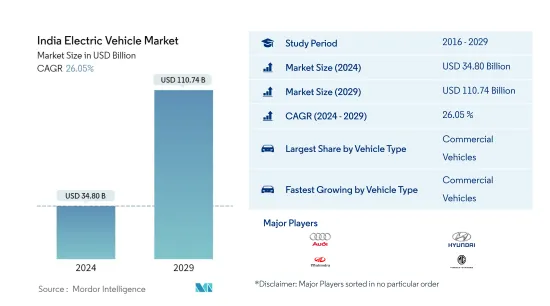Need help finding what you are looking for?
Contact Us
PUBLISHER: Mordor Intelligence | PRODUCT CODE: 1441526

PUBLISHER: Mordor Intelligence | PRODUCT CODE: 1441526
India Electric Vehicle - Market Share Analysis, Industry Trends & Statistics, Growth Forecasts (2024 - 2029)
PUBLISHED:
PAGES: 233 Pages
DELIVERY TIME: 2-3 business days
SELECT AN OPTION
The India Electric Vehicle Market size is estimated at USD 34.80 billion in 2024, and is expected to reach USD 110.74 billion by 2029, growing at a CAGR of 26.05% during the forecast period (2024-2029).

Key Highlights
- Largest Segment by Fuel Type - HEV : The reasons influencing the rise of BEV are state subsidies and the continued encouragement of BEV adoption among Indian private automobile owners and corporate and leasing fleets.
- Fastest-growing Segment by Fuel Type - HEV : Government norms, incentives and rebates, and awareness of e-mobility are attracting consumers to buy EVs, further is making BEV the fastest-growing segment in the Indian electric vehicle market.
- Largest Segment by Vehicle Type - Commercial Vehicles : The passenger vehicle acquired the largest sales in electric vehicles in India, due to the increasing need of passenger vehicles and there are very few models of electric CV available in the Inida.
India Electric Vehicle Market Trends
Commercial Vehicles is the largest segment by Vehicle Type.
- The FAME program provides a discount on the retail value of passenger cars. These subsidies range from INR 11,000 (USD 165) to INR 24,000 (USD 360) for light hybrids, INR 59,000 (USD 885) to INR 71,000 (USD 1,065) for strong hybrids, and INR 60,000 (USD 900) to INR 1,34,000 for electric vehicles (USD 2,010). Two-wheelers, three-wheelers, buses, light commercial vehicles, and retrofit kits can all receive subsidies.
- The FAME scheme's subsidy is not the only incentive program that influences the Indian market for hybrid and electric automobiles. Along with FAME, the Central Government of India and some state governments, including the Government of the National Capital Territory of Delhi (NCT of Delhi), offer tax advantages that give hybrid and electric vehicles a leg up on conventional automobiles. For instance, the Central Government of India imposes flat excise rates of 12.5% and 6% on hybrid and electric vehicles, while traditional car technologies are subject to excise duties of up to 30% (based on vehicle dimensions and engine capacity). The Central Government of India included a tax on the infrastructure for conventional motor cars in the national FY 2016-17 budget, which ranged from 1% to 4% of the cost of the vehicle.
- Hybrid and electric vehicles were exempt from this tax. In its FY 2016-17 budget, the NCT of Delhi, which is the state government, lowered its state Value Added Tax (VAT) rate from 12.5% for conventional automobiles to 5% for hybrid and electric vehicles. Some or all of these advantages are being passed on to consumers by manufacturers, which is expected to boost sales of hybrid and electric vehicles.
India Electric Vehicle Industry Overview
The India Electric Vehicle Market is moderately consolidated, with the top five companies occupying 53.49%. The major players in this market are Audi AG, Hyundai Motor India, Mahindra & Mahindra Ltd, MG Motor India Pvt. Ltd. and Tata Motors (sorted alphabetically).
Additional Benefits:
- The market estimate (ME) sheet in Excel format
- 3 months of analyst support
Product Code: 93011
TABLE OF CONTENTS
1 EXECUTIVE SUMMARY & KEY FINDINGS
2 REPORT OFFERS
3 INTRODUCTION
- 3.1 Study Assumptions & Market Definition
- 3.2 Scope of the Study
- 3.3 Research Methodology
4 KEY INDUSTRY TRENDS
- 4.1 Population
- 4.2 GDP
- 4.3 CVP
- 4.4 Inflation Rate
- 4.5 Interest Rate For Auto Loans
- 4.6 Battery Price (per Kwh)
- 4.7 Electrification Impact
- 4.8 New XEV Models Announced
- 4.9 Charging Stations Deployment
- 4.10 Regulatory Framework
- 4.11 Value Chain & Distribution Channel Analysis
5 MARKET SEGMENTATION
- 5.1 Vehicle Type
- 5.1.1 Commercial Vehicles
- 5.1.1.1 Buses
- 5.1.1.2 Heavy-duty Commercial Trucks
- 5.1.1.3 Light Commercial Pick-up Trucks
- 5.1.1.4 Light Commercial Vans
- 5.1.1.5 Medium-duty Commercial Trucks
- 5.1.2 Passenger Vehicles
- 5.1.2.1 Hatchback
- 5.1.2.2 Multi-purpose Vehicle
- 5.1.2.3 Sedan
- 5.1.2.4 Sports Utility Vehicle
- 5.1.3 Two-Wheelers
- 5.1.1 Commercial Vehicles
- 5.2 Fuel Type
- 5.2.1 BEV
- 5.2.2 FCEV
- 5.2.3 HEV
- 5.2.4 PHEV
6 COMPETITIVE LANDSCAPE
- 6.1 Key Strategic Moves
- 6.2 Market Share Analysis
- 6.3 Company Landscape
- 6.4 Company Profiles
- 6.4.1 Audi AG
- 6.4.2 BMW India Pvt Ltd
- 6.4.3 Hyundai Motor India
- 6.4.4 Jaguar Land Rover Limited
- 6.4.5 Mahindra & Mahindra Ltd
- 6.4.6 Mercedes-Benz AG
- 6.4.7 MG Motor India Pvt. Ltd.
- 6.4.8 Olectra Greentech Limited
- 6.4.9 Tata Motors
- 6.4.10 Toyota Motor Corporation
7 KEY STRATEGIC QUESTIONS FOR VEHICLES CEOS
8 APPENDIX
- 8.1 Global Overview
- 8.1.1 Overview
- 8.1.2 Porter's Five Forces Framework
- 8.1.3 Global Value Chain Analysis
- 8.1.4 Market Dynamics (DROs)
- 8.2 Sources & References
- 8.3 List of Tables & Figures
- 8.4 Primary Insights
- 8.5 Data Pack
- 8.6 Glossary of Terms
Have a question?


SELECT AN OPTION
Have a question?


Questions? Please give us a call or visit the contact form.
